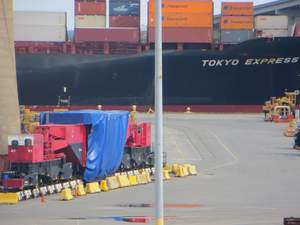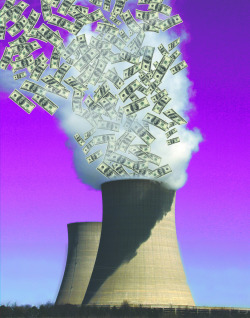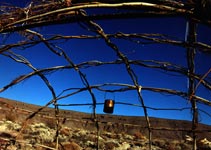The nuclear relapse has derailed -- literally!
 Photo by Tom Clements, Alliance for Nuclear Accountability (ANA)Tom Clements of Alliance for Nuclear Accountability in South Carolina has documented, in photo and blog, a most remarkable development: the AP1000 nuclear reactor vessel targeted at Vogtle, Georgia has been discovered unprotected, stranded in Savannah Port since a December 15 shipment failure. Tom's remarkable blog is posted at the Aiken Leader. Connect Savannah has also reported on the "Nuclear Train Wreck."
Photo by Tom Clements, Alliance for Nuclear Accountability (ANA)Tom Clements of Alliance for Nuclear Accountability in South Carolina has documented, in photo and blog, a most remarkable development: the AP1000 nuclear reactor vessel targeted at Vogtle, Georgia has been discovered unprotected, stranded in Savannah Port since a December 15 shipment failure. Tom's remarkable blog is posted at the Aiken Leader. Connect Savannah has also reported on the "Nuclear Train Wreck."
As Tom has described it: the reactor pressure vessel (RPV) for the chronically delayed Vogtle AP1000 reactor construction project near Waynesboro, Georgia sits stranded and seemingly unprotected in the port of Savannah. The special railroad car carrying the 300-ton vessel had unknown mechanical problems on December 15 on exiting the port. The NRC has said that the vessel only got one-quarter mile before a sound was heard and the car stopped. Plans by Westinghouse and Southern Company to move the vessel are unknown. It is also unknown if the railroad car can be repaired and used or if the railroad company which owns the line is concerned that the rail car might break down again on its line in an in accessible place. Meanwhile, the apparently unguarded reactor might be subject to sabotage and sits in apparent violation of NRC quality assurance and "administrative control" regulations.
 admin
admin
 Photo by Tom Clements, Alliance for Nuclear Accountability (ANA).In a Jan. 22nd update entitled 'Vogtle Nuclear Reactor Still Stranded in Savannah; Pouring of “Nuclear Concrete” for Reactor’s Basemat Delayed Yet Again as Embarrassment and Costs Mount,' Tom Clements of Alliance for Nuclear Accountability gives the latest on the failed shipment of an AP-1000 reactor pressure vessel (RPV) from the Port of Savannah, GA bound for the Vogtle nuclear power plant in Georgia. This includes photos taken by Tom on Jan. 19th (see photo, left). Remarkably, not only Southern Co., but also Westinghouse and even the Korean manufacturer of the RPV have remained silent about the failed shipment, the condition of the RPV, and plans for next steps.
Photo by Tom Clements, Alliance for Nuclear Accountability (ANA).In a Jan. 22nd update entitled 'Vogtle Nuclear Reactor Still Stranded in Savannah; Pouring of “Nuclear Concrete” for Reactor’s Basemat Delayed Yet Again as Embarrassment and Costs Mount,' Tom Clements of Alliance for Nuclear Accountability gives the latest on the failed shipment of an AP-1000 reactor pressure vessel (RPV) from the Port of Savannah, GA bound for the Vogtle nuclear power plant in Georgia. This includes photos taken by Tom on Jan. 19th (see photo, left). Remarkably, not only Southern Co., but also Westinghouse and even the Korean manufacturer of the RPV have remained silent about the failed shipment, the condition of the RPV, and plans for next steps.
Meanwhile, not only Vogtle 3 & 4, but also the proposed new AP1000 at Summer nuclear power plant in South Carolina, have made LARs (License Amendment Requests) due to difficulties encountered in the pouring of nuclear-grade concrete for the base mat under the reactors and containments themselves. The consequent delays, and hence cost overruns, associated with all these ongoing problems could well be substantial.
As Tom Clements of ANA wrote regarding the photo (above, left): 'Photo taken on January 19 of close-up of Schnabel rail car with Vogtle "reactor pressure vessel" hidden by a tarp. The 300-ton reactor vessel was manufactured by Doosan in Korea and shipped through the Panama Canal to Savannah. More photos are linked at [http://aikenleader.villagesoup.com/p/vogtle-nuclear-reactor-still-stranded-in-savannah-pouring-of-nuclear-concrete-for-reactor-s-basema/951066], which also includes a link to the January 14 article which has more photos. How long will this embarrassing and potentially costly situation continue? It's time for Westinghouse and Southern Company to come clean about the reactor shipment but will the companies, which are profiting due to an unjust Georgia law which forces rate payers to pay in advance for the Vogtle AP1000 project, continue their perplexing silence? It is believed that South Carolina Electric & Gas (SCE&G) has a similar Schnabel rail car, owned by Westinghouse, at its disposal in the port of Charleston, where components for the V.C. Summer AP1000 are received. Given what has happened with the Vogtle reactor shipment, will problems develop if a similar shipment is ever undertaken from Charleston to SCE&G's V.C. Summer site near Jenkinsville, South Carolina?'








